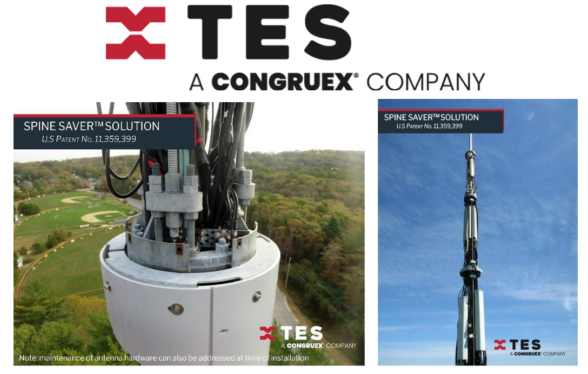Today’s telecom poles are stressed. Because of the increased demand for colocation that began in the 1990’s and larger carrier equipment used for ever increasing network demand, the diameter of the Concealed Design Structure (CDS) canisters needed to be increased. In other cases, the canisters have needed to be extended.
“These canister expansions and extensions often cause the failure of the existing spines,” said Jaime Reyes, Vice President Operations at Tower Engineering Solutions (TES), a Congruex company.
The Spine Saver™ from TES is a patented method for reinforcing CDS poles. There is no need to drop and swap, eliminating the full removal and replacement of the spine, thereby avoiding coverage interruption and extensive network planning to provide coverage such as setting up temporary sites. This approach increases capacity at a cost savings of up to 50 percent over traditional solutions, according to Reyes. The Spine Saver™ is the only CDS solution used by two major carriers and a major tower company, says TES.
“The motivation was the need to avoid spine replacement,” Reyes said. “Replacing a failing spine on a CDS pole carries a significant cost of time and money, which is compounded when there are multiple carriers who will need to be temporarily relocated by the use of COWs, or other temporary sites. Before the Spine Saver™, there was no option other than full spine replacement.”
The Spine Saver™ also reduces damage to canisters and shrouds from a phenomenon known as vortex shedding. This wind-induced oscillation can cause severe damage to the shrouds and can even result in the catastrophic failure of stealth canister sections.
“This problem is well known and is difficult to predict or remediate, leaving the structure owner with no choice but to replace the damaged sections,” Reyes explained. “The Spine Saver™ offers the benefit of increasing the stiffness of the canister spine, significantly reducing, or preventing the occurrence of vortex shedding. It can be used for this purpose, even when a spine is not failing.”
The Spine Saver™ solution works by connecting structural members between the flanges of the existing spine. These new structural members serve to stiffen the spine, allowing for higher bending moments and reducing the deflection of the spine.
“What differentiates us from the alternatives is that the existing spine is utilized, which reduces the cycle time. Additionally, because the load capacity is increased, the value of the asset improves,” Reyes said.
Conclusion
As wireless demand grows and the need to upgrade carrier equipment increases, so will the demand on CDS poles, particularly those in more urban areas. TES’ Spine Saver™ solution reinforces the existing tower’s spine, which allows the carriers to remain on-air while upgrading, thereby avoiding costly capital expense and saving valuable time. Additionally, the solution is a viable way of remediating the effects of vortex shedding.
For more information, contact Tracy McQueen at 678-362-4790 ([email protected]) or Wade Collins ([email protected]) at 615-714-8202.
For more information on the Spine Saver™ patented solutions as well as other TES patented solutions, please see the TES patent information page at www.congruex.com/tespatents.




Reader Interactions